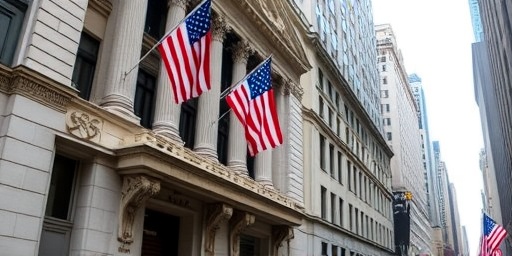In a swift response to mounting financial pressures, Wall Street‘s major banking institutions are overhauling their fraud detection systems, demanding unprecedented access to borrower data and ramping up due diligence processes. This crackdown comes as loan losses have spiked by over 25% in the past quarter, fueled by economic uncertainties and a wave of deceptive lending practices uncovered in recent audits.
- Loan Losses Escalate: A $50 Billion Wake-Up Call for Wall Street
- Banks Deploy Advanced Due Diligence to Combat Fraud Threats
- Regulatory Crackdown: SEC and FDIC Push for Tighter Banking Controls
- Impact on Borrowers: Navigating Stricter Wall Street Lending Landscape
- Future Horizons: AI and Collaboration Shape Banking’s Anti-Fraud Frontier
Loan Losses Escalate: A $50 Billion Wake-Up Call for Wall Street
The financial sector is reeling from a dramatic uptick in loan losses, with reports indicating that U.S. banks alone have written off more than $50 billion in bad loans since the start of the year. This surge, primarily affecting commercial real estate and small business lending portfolios, has prompted emergency board meetings at firms like JPMorgan Chase and Goldman Sachs. Analysts attribute the rise to a combination of post-pandemic economic recovery lags and sophisticated fraud schemes that have infiltrated lending pipelines.
According to a recent Federal Reserve bulletin, non-performing loans now account for 4.2% of total outstanding credit, up from 2.8% just 12 months ago. In the heart of Wall Street, where high-stakes deals define the market, this escalation is not just a numbers game—it’s a threat to investor confidence. ‘We’ve seen a perfect storm,’ said Elena Vasquez, a senior economist at the New York Federal Reserve. ‘Rising interest rates have squeezed borrowers, but the real culprit is fraud exploiting these vulnerabilities.’
One notable case involved a mid-sized lender in Manhattan that discovered $200 million in fraudulent small business loans last month. The scheme involved falsified revenue documents and shell companies, highlighting how fraudsters are adapting to digital lending platforms. Wall Street banks, which underwrite trillions in loans annually, are now facing the fallout, with stock prices of major players dipping by an average of 3% in after-hours trading following the latest loss disclosures.
Banks Deploy Advanced Due Diligence to Combat Fraud Threats
To stem the tide of loan losses, leading Wall Street institutions are implementing rigorous due diligence protocols that go beyond traditional credit checks. JPMorgan Chase, for instance, announced last week that it would integrate AI-driven analytics into its loan approval workflow, requiring real-time access to borrowers’ financial records, tax filings, and even social media activity for high-risk applicants.
This shift marks a departure from the faster, less intrusive processes that dominated banking during the low-interest era. ‘Due diligence isn’t optional anymore—it’s the frontline defense against fraud,’ stated Marcus Hale, chief risk officer at Bank of America. In a memo leaked to financial news outlets, the bank outlined plans to hire 500 additional compliance specialists focused on fraud detection, with a budget allocation of $300 million for the fiscal year.
Other measures include mandatory third-party verifications and blockchain-based tracking for loan disbursements. Citigroup, another Wall Street heavyweight, has partnered with fintech firm Veriff to enhance identity verification, reducing the risk of synthetic identity fraud—a tactic where criminals create fake personas using stolen data. Statistics from the American Bankers Association show that such fraud contributed to 15% of all loan losses in 2023, underscoring the urgency of these upgrades.
Smaller regional banks are following suit, though with varying degrees of success. A survey by Deloitte revealed that 78% of banking executives plan to increase due diligence spending by at least 20% in the coming quarters, driven by regulatory pressures from the Office of the Comptroller of the Currency (OCC). This heightened scrutiny is reshaping how Wall Street interacts with borrowers, potentially slowing loan approvals but safeguarding against deeper losses.
Regulatory Crackdown: SEC and FDIC Push for Tighter Banking Controls
Federal regulators are amplifying their role in this Wall Street fraud battle, with the Securities and Exchange Commission (SEC) and Federal Deposit Insurance Corporation (FDIC) issuing joint guidelines last Tuesday that mandate enhanced reporting on loan loss provisions. These rules require banks to disclose fraud-related incidents within 48 hours, a stark contrast to previous quarterly filings.
‘The era of opaque lending practices is over,’ declared SEC Chair Gary Gensler in a press briefing. ‘Wall Street must prioritize transparency to protect the broader economy from systemic risks posed by unchecked fraud.’ The FDIC has already fined two major banks $10 million each for inadequate due diligence in loan origination, serving as a warning shot to the industry.
In response, Wall Street lobbying groups like the Securities Industry and Financial Markets Association (SIFMA) have called for balanced regulations that don’t stifle innovation. However, insiders report that compliance costs could rise by 15-20% across banking sectors, potentially passing those expenses onto consumers through higher interest rates. A case in point is Wells Fargo, which recently settled a $185 million fraud probe related to unauthorized account openings—a scandal that echoes current loan loss concerns.
Internationally, the trend is mirroring in Europe, where the European Banking Authority is proposing similar data access requirements. This global alignment could standardize anti-fraud measures, but it also raises privacy concerns. Advocacy groups like the Electronic Privacy Information Center (EPIC) warn that expansive data demands might infringe on borrower rights, sparking debates in congressional hearings scheduled for next month.
Impact on Borrowers: Navigating Stricter Wall Street Lending Landscape
As Wall Street tightens its grip on fraud prevention, everyday borrowers are feeling the pinch. Small business owners, in particular, report longer approval times—up to 45 days from the previous 30—and more invasive document requests. ‘It’s like applying for a loan now requires baring your soul,’ quipped Sarah Lin, owner of a Brooklyn-based tech startup that faced delays in securing a $500,000 line of credit.
Statistics from the National Federation of Independent Business indicate that 62% of small firms have encountered heightened scrutiny in loan applications this year, correlating directly with the rise in loan losses. For consumers, mortgage and auto loan seekers are seeing credit score thresholds elevated, with some banks now requiring FICO scores above 720 for standard approvals.
Yet, not all impacts are negative. Enhanced due diligence is weeding out predatory lenders and reducing default rates in vetted portfolios. A study by McKinsey & Company found that banks employing advanced fraud checks experienced 30% fewer losses in pilot programs. Wall Street’s pivot is also fostering innovation, with startups like Plaid and Alloy offering streamlined verification tools that balance security and speed.
Low-income communities, however, risk being disproportionately affected. Community development advocates argue that stricter checks could exacerbate lending deserts, where access to capital is already limited. In response, some banks are launching targeted programs, such as Goldman Sachs’ $750 million small business equity fund, aimed at underserved markets while maintaining robust anti-fraud safeguards.
Future Horizons: AI and Collaboration Shape Banking’s Anti-Fraud Frontier
Looking ahead, Wall Street’s battle against fraud and loan losses is poised to evolve through technological and collaborative advancements. Industry forecasts predict that by 2025, AI will underpin 70% of due diligence processes in banking, according to Gartner research. Firms like Morgan Stanley are investing in machine learning models that detect anomalies in loan applications with 95% accuracy, potentially slashing losses by half.
Cross-industry partnerships are another key trend. The Financial Services Information Sharing and Analysis Center (FS-ISAC) is expanding its fraud intelligence network, allowing banks to share threat data anonymously. ‘Collaboration is our strongest weapon,’ noted FS-ISAC Director Tim Clemente. This could lead to a more resilient Wall Street, but challenges remain, including cybersecurity risks from increased data sharing.
Economists anticipate that if loan losses stabilize, interest rates might ease by mid-2024, boosting lending volumes. However, persistent fraud could trigger broader market volatility, with ripple effects on stock indices like the Dow Jones. Regulators are monitoring closely, with potential for new legislation like the proposed Banking Fraud Prevention Act, which would allocate $1 billion for anti-fraud tech grants.
For investors, this tightening signals a maturing sector focused on sustainability. As one hedge fund manager put it, ‘Wall Street’s learning that prevention beats cure—especially when the cure costs billions in loan losses.’ The path forward demands vigilance, innovation, and a commitment to ethical banking practices to restore trust in an era of economic flux.









